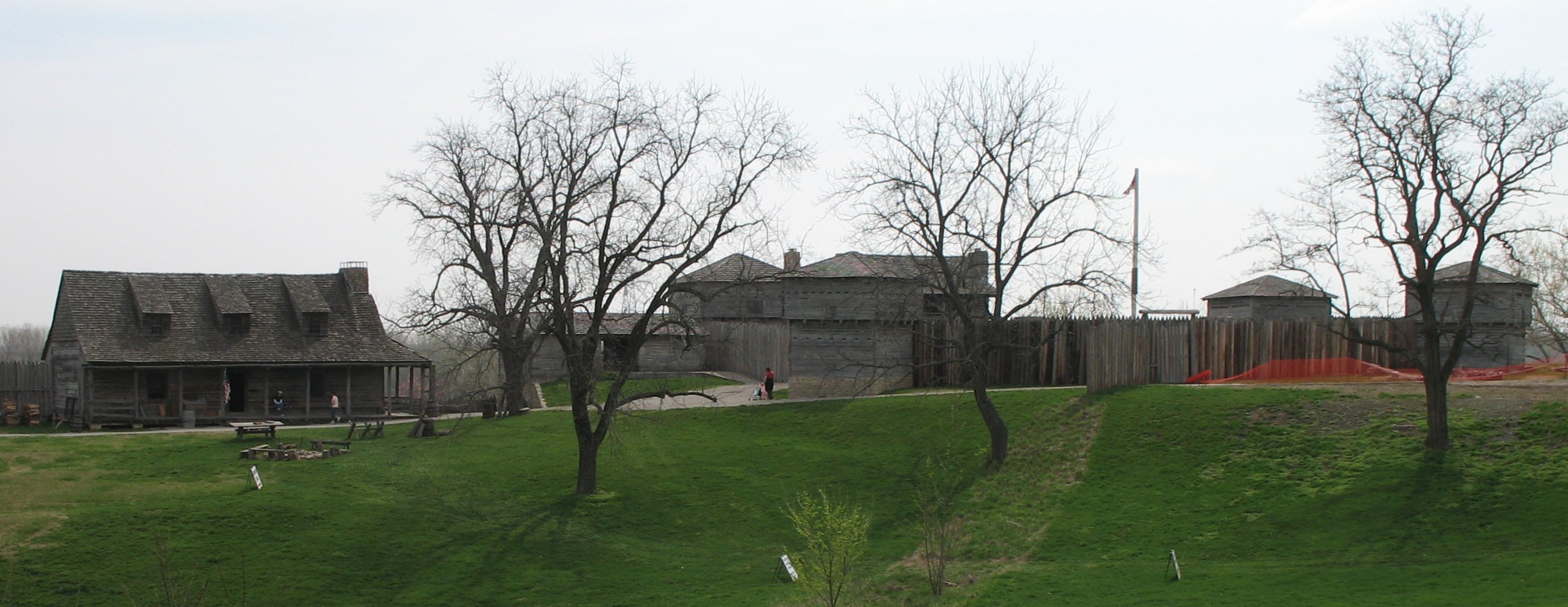- Fort Osage
Infobox_nrhp | name =Fort Osage
nrhp_type = nhld

caption = Fort Osage from the west. The "factory" trading post is on the left
location=Sibley, Missouri
locmapin = Missouri
area =
built =1802
architect=
architecture= No Style Listed
designated=November 05 ,1961 cite web|url=http://tps.cr.nps.gov/nhl/detail.cfm?ResourceId=290&ResourceType=District|title=Fort Osage |accessdate=2008-06-28|work=National Historic Landmark summary listing|publisher=National Park Service]
added =October 15 ,1966
governing_body = Local
refnum=66000418cite web|url=http://www.nr.nps.gov/|title=National Register Information System|date=2007-01-23|work=National Register of Historic Places|publisher=National Park Service]Fort Osage (also known as Fort Clark or Fort Sibley) was part of the United States factory
trading post system for theOsage Nation in the early 19th century nearSibley, Missouri .The Osage in exchange for access to the trading post above the
Missouri River in 1808 in theTreaty of Fort Clark ceded all of their lands east of the fort inLouisiana Territory effectively leaving them with a small band of territory on the extreme western border of Missouri.The fort ceased operations in the 1820s as the Osage in subsequent treaties ceded the rest of their land in Missouri. A replica of the fort was rebuilt on the site in the 1950s.
History
Lewis and Clark noted the spot on June 1804 noting it: [ [http://www.cr.nps.gov/nr/travel/lewisandclark/osa.htm Fort Osage - National Park Service] ]:high commanding position, more than 70 feet above high-water mark, and overlooking the river, which is here but of little depth
Also, in 1804
Pierre Chouteau of theChouteau fur trading family and anagent for the Osage took Osage chiefs to meet PresidentThomas Jefferson who promised to build them a trading post.In 1808 Chouteau negotiated a deal for the fort to be built for the protection of the Osage. The specific terms of the deal noted: [ [http://digital.library.okstate.edu/Kappler/Vol2/treaties/osa0095.htm#mn1 Treaty of Fort Clark] ]
:The United States being anxious to promote peace, friendship and intercourse with the Osage tribes, to afford them every assistance in their power, and to protect them from the insults and injuries of other tribes of Indians, situated near the settlements of the white people, have thought proper to build a fort on the right bank of the Missouri, a few miles above the Fire Prairie, and do agree to garrison the same with as many regular troops as the President of the United States may, from time to time, deem necessary for the protection of all orderly, friendly and well disposed Indians of the Great and Little Osage nations, who reside at this place, and who do strictly conform to, and pursue the counsels or admonitions of the President of the United States through his subordinate officers.
In order to get the protection, the Osage ceded all of Missouri east of the fort. The Great Osage were to receive $1,000 and the Little Osage were to get $500.
The fort was initially referred to as Fort Clark in honor of William Clark who was in charge of Indian Affairs. It was one of the first United States military installations in Louisiana Territory became a major stopping point for visitors traveling the Missouri.
Daniel Boone was to visit it in 1814.It subsequently became known as "Fort Osage" and then was informally called "Fort Sibley" for
George Sibley who succeeded Chouteau as the Osage Indian agent. Sibley's 16 year old wife held piano concerts for the mountainmen and traders that visited the Fort.As the Osage ceded more and more of their land a new trading post at
Fort Scott, Kansas was established closer to the ancestral villages near the headwaters of theOsage River nearNevada, Missouri and its Osage mission formally ended in 1822.The fort remained a landmark on the
Santa Fe Trail and by 1836 it had been totally obliterated with its pre-cut wood used for other purposes.In the 1950's, archeologists discovered the foundations of these buildings and rebuilt the Fort as closely as they could, it now stands, overlooking the Missouri River once again. A school district just outside Independence was named for it.
Fort Osage National Historic Landmark
Currently the fort is known as Fort Osage National Historic Landmark and has been reconstructed to portray Fort Osage as it was in 1812. Living history demonstrations are given about early 19th century military and civilian life.
The Fort Osage Education Center, opened in November 2007, contains exhibits about the site's geology, 19th century
natural history , the Hopewell and Osage native cultures,Lewis and Clark , Fort Osage and theMissouri River .References
External links
* [http://www.jacksongov.org/content/3279/3838/3861.aspx Fort Osage National Historic Landmark]
* [http://www.epsi.net/graphic/osage.html Ft. Osage] - another site
Wikimedia Foundation. 2010.
